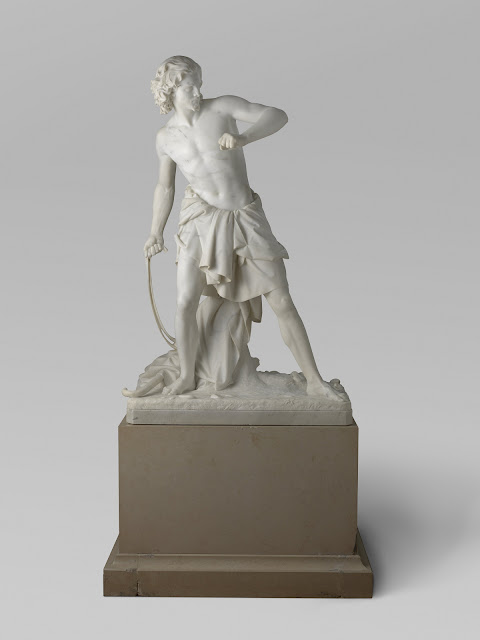 |
| François Coudray St Sebastian 1712 marble Musée du Louvre |
 |
| Giovanni Antonio Amadeo Three Adoring Angels ca. 1490-1510 marble Victoria & Albert Museum |
"Three Adoring Angels was made in the Lombard workshop of Giovanni Antonio Amadeo around the turn of the sixteenth century. The expressions of grief on the faces suggest that this relief formed part of a Lamentation group with mourning figures gathered around the body of Christ. The jagged clinging drapery style is typical of several Lombard sculptors. It is sometimes referred to as 'cartaceous' drapery because it resembles crumpled paper. . . . The present relief formed a decorative frame for the main sculpture and would probably have been designed by Amadeo but executed by a skilled assistant under his close supervision. The master would perhaps have supplied the finishing touches or adjusted any mistakes, rather than carve the entire piece himself."
 |
| Anonymous Italian sculptor Aeneas and Anchises ca. 1525-50 marble Rijksmuseum, Amsterdam |
 |
| Augustus Saint-Gaudens Hiawatha 1874 marble Metropolitan Museum of Art, New York |
"Saint-Gaudens's three years of study in Paris came to an abrupt end with the outbreak of the Franco-Prussian War. He left for Rome in late 1870 and soon began Hiawatha – his first full-length statue, inspired by Henry Wadsworth Longfellow's epic poem The Song of Hiawatha (1855). Seated on a rock in a contemplative pose with his quiver of arrows and bow nearby, the Chippewa chief is "pondering, musing in the forest / On the welfare of his people," as an excerpt from Longfellow's poem inscribed on the base declares. Saint-Gaudens worked only briefly in such a romanticized Neoclassical manner before progressing to the fluid Beaux-Arts style of his innovative bronze monuments and low-relief portraits."
 |
| Ancient Greece Nike late 5th century BC marble relief fragment Metropolitan Museum of Art, New York |
 |
| Roman Empire Matron AD 60-70 marble Minneapolis Institute of Art |
"Once identified as Agrippina the Younger, mother of the emperor Nero, this portrait statue is now designated as an unidentified Roman matron. The hairstyle corresponds to a fashion current in Nero's reign. The stark realistic depiction of the woman's bony and lined face contrasts with the gracefully flowing, deeply carved folds of the clothing (characteristic of Hellenistic sculpture). This subtle combination of realism and idealism was common in portraiture of the Roman Republic and Empire, particularly during the reigns of the Julio-Claudian emperors and Hadrian."
 |
| Pietro Magni David 1851 marble Rijksmuseum, Amsterdam |
 |
| Anonymous South Netherlandish sculptor Virgin supported by St John ca. 1340-50 marble Metropolitan Museum of Art, New York |
"Said to have come from the collegiate church of Notre-Dame at Huy in Belgium, these figures were probably part of a large sculptural retable behind the altar."
 |
| Lupo di Francesco Virgin and Child with two Angels ca. 1315-36 marble relief Victoria & Albert Museum |
 |
| Pietro Lombardo Lunette with Virgin and Child, kneeling Nuns, and Angels ca. 1480-1500 Istrian Stone relief Victoria & Albert Museum |
"This lunette, carved for an unidentified convent church, depicts two nuns. The one kneeling on the Virgin's right holds a crosier, which suggests that she is the abbess. The two kneeling nuns are the donors. It was common practice for people to pay for objects or decorations in a church, partly to show their piety but also to reduce their time in Purgatory. The shape and imagery of this relief suggest that it comes from an external doorway."
 |
| workshop of The Master of the St Sebastian Martyrdoms Fall of Man ca. 1630-50 ivory Wadsworth Atheneum, Hartford, Connecticut |
 |
| Étienne Bobillet and Paul Mosselman Mourner from the tomb of Jean, duc de Berry at Bourges ca. 1453 alabaster Metropolitan Museum of Art, New York |
"The tomb at Bourges of Jean, duc de Berry (1340-1416) was begun by Jean de Cambrai and completed by Étienne Bobillet and Paul de Mosselman. For the duke's tomb, his life-size portrait-effigy was placed on top of a sarcophagus, with figures of mourners rendered in high relief along its sides. The idea of surrounding the tomb with such figures most likely derived from an early thirteenth-century custom of attaching tokens of sorrowful remembrance of the deceased to his sarcophagus. Here, the figures may represent specific members of the duke's family. The faces of the mourners are hidden by deep hoods, and their bodies are engulfed by the voluminous cloaks so typical of Burgundian sculpture. The duke's tomb was vandalized during the French Revolution, and the mourner figures were destroyed or dispersed. Of the original forty statuettes, only twenty-five survive, including these impressive examples."
 |
| Étienne Bobillet and Paul Mosselman Mourner from the tomb of Jean duc de Berry at Bourges ca. 1453 alabaster Metropolitan Museum of Art, New York |
 |
| Roman Empire Two men AD 50-75 bronze relief Getty Museum, Los Angeles |
"Two men wearing togas turn to look at some action to their right. As is clear from the break of the piece on the right, they are all that remains of what was once a large bronze relief frieze. The figures are clearly different ages and show strongly individualized, almost portrait-like features. The older man carries a scroll, which probably marks him as a priest. The larger scene may have shown some kind of sacrifice to the gods. Stylistic features of the figures' clothing and hairstyles date the relief to the reign of Nero. The back of this fragment is completely unfinished. It was reportedly found with the statuette of a goddess, probably Ceres, and the statuette of Roma or Virtus. Together, all of these pieces seem to have formed a group of relief sculpture which may have served as appliqué decorating the same object, perhaps a chariot or a piece of furniture."
– quoted texts based on curator's notes from the respective museums